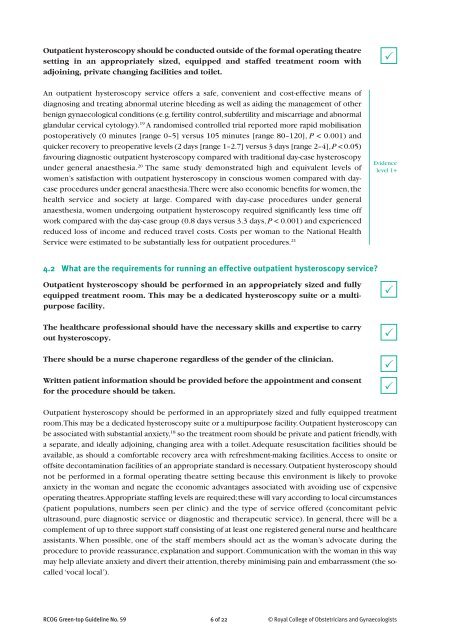Best Practice in Outpatient Hysteroscopy - British Society for ...
Best Practice in Outpatient Hysteroscopy - British Society for ...
Best Practice in Outpatient Hysteroscopy - British Society for ...
Create successful ePaper yourself
Turn your PDF publications into a flip-book with our unique Google optimized e-Paper software.
<strong>Outpatient</strong> hysteroscopy should be conducted outside of the <strong>for</strong>mal operat<strong>in</strong>g theatre<br />
sett<strong>in</strong>g <strong>in</strong> an appropriately sized, equipped and staffed treatment room with<br />
adjo<strong>in</strong><strong>in</strong>g, private chang<strong>in</strong>g facilities and toilet.<br />
An outpatient hysteroscopy service offers a safe, convenient and cost-effective means of<br />
diagnos<strong>in</strong>g and treat<strong>in</strong>g abnormal uter<strong>in</strong>e bleed<strong>in</strong>g as well as aid<strong>in</strong>g the management of other<br />
benign gynaecological conditions (e.g.fertility control,subfertility and miscarriage and abnormal<br />
glandular cervical cytology). 19 A randomised controlled trial reported more rapid mobilisation<br />
postoperatively (0 m<strong>in</strong>utes [range 0–5] versus 105 m<strong>in</strong>utes [range 80–120], P < 0.001) and<br />
quicker recovery to preoperative levels (2 days [range 1–2.7] versus 3 days [range 2–4],P < 0.05)<br />
favour<strong>in</strong>g diagnostic outpatient hysteroscopy compared with traditional day-case hysteroscopy<br />
under general anaesthesia. 20 The same study demonstrated high and equivalent levels of<br />
women’s satisfaction with outpatient hysteroscopy <strong>in</strong> conscious women compared with daycase<br />
procedures under general anaesthesia.There were also economic benefits <strong>for</strong> women, the<br />
health service and society at large. Compared with day-case procedures under general<br />
anaesthesia, women undergo<strong>in</strong>g outpatient hysteroscopy required significantly less time off<br />
work compared with the day-case group (0.8 days versus 3.3 days,P < 0.001) and experienced<br />
reduced loss of <strong>in</strong>come and reduced travel costs. Costs per woman to the National Health<br />
Service were estimated to be substantially less <strong>for</strong> outpatient procedures. 21<br />
4.2 What are the requirements <strong>for</strong> runn<strong>in</strong>g an effective outpatient hysteroscopy service?<br />
<strong>Outpatient</strong> hysteroscopy should be per<strong>for</strong>med <strong>in</strong> an appropriately sized and fully<br />
equipped treatment room. This may be a dedicated hysteroscopy suite or a multipurpose<br />
facility.<br />
The healthcare professional should have the necessary skills and expertise to carry<br />
out hysteroscopy.<br />
There should be a nurse chaperone regardless of the gender of the cl<strong>in</strong>ician.<br />
Written patient <strong>in</strong><strong>for</strong>mation should be provided be<strong>for</strong>e the appo<strong>in</strong>tment and consent<br />
<strong>for</strong> the procedure should be taken.<br />
<strong>Outpatient</strong> hysteroscopy should be per<strong>for</strong>med <strong>in</strong> an appropriately sized and fully equipped treatment<br />
room.This may be a dedicated hysteroscopy suite or a multipurpose facility. <strong>Outpatient</strong> hysteroscopy can<br />
be associated with substantial anxiety, 18 so the treatment room should be private and patient friendly,with<br />
a separate, and ideally adjo<strong>in</strong><strong>in</strong>g, chang<strong>in</strong>g area with a toilet.Adequate resuscitation facilities should be<br />
available, as should a com<strong>for</strong>table recovery area with refreshment-mak<strong>in</strong>g facilities.Access to onsite or<br />
offsite decontam<strong>in</strong>ation facilities of an appropriate standard is necessary.<strong>Outpatient</strong> hysteroscopy should<br />
not be per<strong>for</strong>med <strong>in</strong> a <strong>for</strong>mal operat<strong>in</strong>g theatre sett<strong>in</strong>g because this environment is likely to provoke<br />
anxiety <strong>in</strong> the woman and negate the economic advantages associated with avoid<strong>in</strong>g use of expensive<br />
operat<strong>in</strong>g theatres.Appropriate staff<strong>in</strong>g levels are required;these will vary accord<strong>in</strong>g to local circumstances<br />
(patient populations, numbers seen per cl<strong>in</strong>ic) and the type of service offered (concomitant pelvic<br />
ultrasound, pure diagnostic service or diagnostic and therapeutic service). In general, there will be a<br />
complement of up to three support staff consist<strong>in</strong>g of at least one registered general nurse and healthcare<br />
assistants. When possible, one of the staff members should act as the woman’s advocate dur<strong>in</strong>g the<br />
procedure to provide reassurance,explanation and support.Communication with the woman <strong>in</strong> this way<br />
may help alleviate anxiety and divert their attention,thereby m<strong>in</strong>imis<strong>in</strong>g pa<strong>in</strong> and embarrassment (the socalled<br />
‘vocal local’).<br />
RCOG Green-top Guidel<strong>in</strong>e No. 59 6 of 22 © Royal College of Obstetricians and Gynaecologists<br />
<br />
Evidence<br />
level 1+



